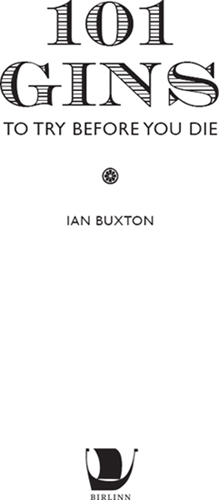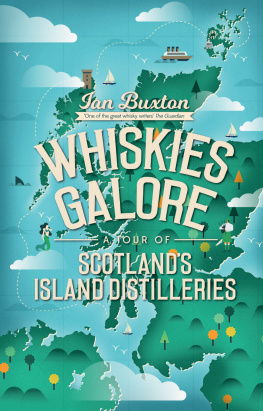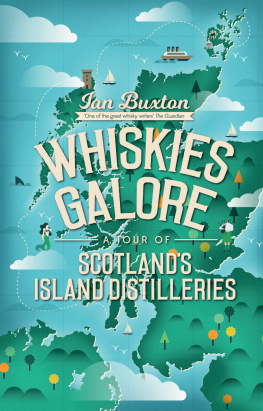101
GINS
TO TRY BEFORE YOU DIE

First published in Great Britain in 2015
by Polygon, an imprint of Birlinn Ltd
West Newington House
10 Newington Road
Edinburgh
EH9 1QS
www.birlinn.co.uk
ISBN: 978 1 78027 299 3
eISBN: 978 0 85790 246 7
Copyright Ian Buxton, 2015
All rights reserved. No part of this publication may be reproduced, stored, or transmitted in any form, or by any means electronic, mechanical or photocopying, recording or otherwise, without the express written permission of the publisher.
The moral right of Ian Buxton to be identified as the author of this work has been asserted by him in accordance with the Copyright, Designs and Patents Act 1988
British Library Cataloguing-in-Publication Data
A catalogue record for this book is available on request from the British Library
Designed by Teresa Monachino
Printed and bound by 1010 Printing International, Hong Kong
C ONTENTS



INTRODUCTION
W ere in the middle of a new Gin Craze. From being the drink of choice of middle-aged, Jaguar-driving golfers and an easy target for stand-up comedians, today its harder to find anything hipper on the international bar scene.
This is by way of an exploration. I want to see how Madam Geneva, scourge of the drinking classes and emblematic of wantonness, sin and ruin has evolved into the most fashionable of spirits. How a drink reeking of suburbia, Home Counties complacency and golf-club lounges is now found in cutting-edge cocktail bars around the world. And how what you might once have described as the Nigel Farage of drinks has morphed into its Cara Delevingne. (Disclaimer: I have no idea what the divine Cara drinks. We move in different circles, and for all I know shes tucked up in bed well before News at Ten with a tasty glass of organic green tea the point, as Im sure youve gathered, is that gin is hot.)
Rowlandson and, famously, Hogarth placed gin at the heart of much of their work. Commentators too, such as Defoe, Fielding, Dickens and many others had much to say about it, not to mention those eighteenth-century politicians who legislated with such enthusiasm (and such a lack of noticeable effect) to curb the English taste for gin.
Or should that be Dutch? They gave the world genever which the English made their own, leading rapidly to Londons original (and infamous) Gin Craze. It may have taken more than 250 years, but gin has now shaken off its reputation for debauchery and ruin to take its place as one of the hottest of world spirits.
So, from Adnams to Xoriguer (couldnt find a Z I liked; youll see) and London to Plymouth (and beyond) I want to explore this incredible explosion of innovative gin brands and the new generation of young and enthusiastic distillers that are reinventing this most English of drinks.
Not that a hint of debauchery and ruin does its image any harm. But today its all very confusing. Scarcely a day goes by without an established brand offering a fresh take on their established styles or, more likely, a new boutique distillery opening its doors where gin is de rigueur. However, before we dive into that particular madness a little bit of history is probably called for.
A LITTLE BIT OF HISTORY
According to the Middlesex Magistrates, gin was the principal cause of all the vice and debauchery committed among the inferior sort of people. Clearly those gentlemen took a robust and not very politically correct view of those making an involuntary and no doubt unwelcome visit to their court back in 1721
So things were pretty over-excited in Georgian England, which for most of the early eighteenth century was in the grip of a binge-drinking frenzy weve come to know as the Gin Craze. Daniel Defoe put up a pretty robust defence of the industry though:
As to the excesses and intemperances of the People, and their drinking immoderate Quantities of Malt Spirits, the Distillers are not concernd in it at all; their Business is to prepare a Spirit wholesome and good. If the People will destroy themselves by their own Excesses, and make that Poison, which is otherwise an Antidote; tis the Magistrates Business to help that, not the Distillers. (The Case of the Distillers, London, 1726)
Mind you, hed been well paid for that piece of enthusiastic spin-doctoring and was as liable to take the side of the moral majority as defend the distilling industry which, incidentally and apart from some pious sermonising about using our products responsibly, hasnt to this day got much further than dont blame us if people get off their face on our products.
You could quite reasonably argue that alcopops and cheap cider are todays equivalent of gin, though as far as I know, no one is yet selling these one shot at a time through a Puss and Mew vending machine. Give them time, though, give them time.
Gins history begins well, no one can quite agree. According to some commentators, not least the ever reliable Wikipedia (so it must be true), the Dutch physician Franciscus Sylvius is to be credited with the invention of gin in the mid-seventeenth century.
But Dutch Courage can be dated to 1585 when English troops supported the Dutch army in their war with the Spanish, and there are written references to genever as early as the thirteenth century.
Im not convinced that it matters. Various nations make various claims for the ancient origins of their national drink; the Scots date whisky to 1494, the Poles claim 1174 for vodka, and the French place Armagnac ahead of cognac with references to 1411. So the English were late to the game with gin, probably sometime in the early seventeenth century. The Worshipful Company of Distillers, Defoes patron, received its royal warrant in 1638, but the first distillers were actually surgeons, much to the displeasure of the apothecaries who took exception to these upstarts and objected to the dilution of their jealously guarded privileges.
The first attempts at gin were an effort to replicate the genever enjoyed by English troops during their long campaigns in Holland during the Thirty Years War (16181648), but it took the arrival of King William III, or William of Orange as he is better known, in the Glorious Revolution of 1688 for gin to raise its game. And raise it, it did, in response to a series of laws aiming to promote distilling in England (and, not entirely coincidentally, the sale of grain which suited the landed interest then dominant in Parliament very nicely indeed).
Soon sales of gin exceeded that of the more expensive beer; little wonder when anyone could start distilling by giving ten days public notice. To the alarm of the genteel and the ruling classes production soared, and in 1729 a licensing system for distillers and publicans was introduced and duty charged. Things got worse: illicitly distilled gin prospered at the expense of legitimate traders. Soon it was estimated that in certain parts of London one private house in four was selling some form of spirits. Regionally the situation was little better and an epidemic of alcohol dependency was taking hold of the poorer parts of the nation.
A further attempt at legislation, the Gin Act of September 1736, merely exacerbated the situation by attempting to restrict retailers and greatly raise the retail price. Though opposed by, among others, the Prime Minister (Sir Robert Walpole) and Dr Samuel Johnson, the law was passed and then routinely ignored. Only two of the infamous 50 distilling licences (equivalent to around 750,000 today) were taken out, while production is thought to have increased by around half.
Next page














